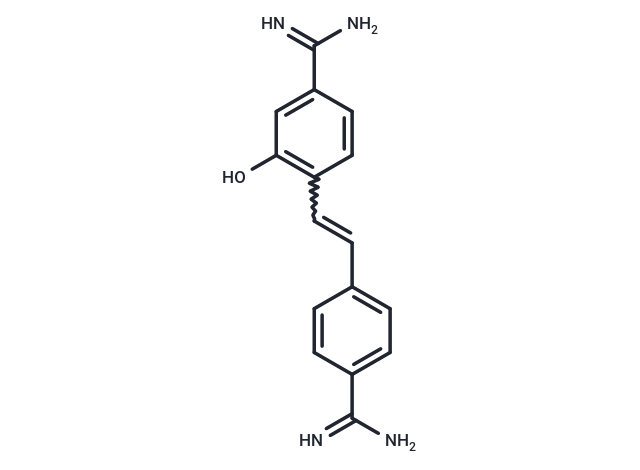Shopping Cart
Remove All Your shopping cart is currently empty
Your shopping cart is currently empty
Hydroxystilbamidine ((E)-hydroxystilbamidine), a dye capable of binding to both DNA and RNA, has been found to be a powerful inhibitor of cellular ribonucleases.

| Pack Size | Price | USA Warehouse | Global Warehouse | Quantity |
|---|---|---|---|---|
| 1 mg | $195 | In Stock | In Stock | |
| 2 mg | $293 | In Stock | In Stock | |
| 5 mg | $447 | In Stock | In Stock | |
| 10 mg | $659 | In Stock | In Stock | |
| 25 mg | $987 | In Stock | In Stock | |
| 50 mg | $1,380 | In Stock | In Stock | |
| 100 mg | $1,890 | In Stock | In Stock | |
| 500 mg | $3,790 | - | In Stock |
| Description | Hydroxystilbamidine ((E)-hydroxystilbamidine), a dye capable of binding to both DNA and RNA, has been found to be a powerful inhibitor of cellular ribonucleases. |
| In vitro | Instructions I. Retrograde neural tracing 1. Material preparation: Hydroxystilbamidine (usually prepared as a 2% solution). Solvent: physiological saline, distilled water, or buffer (such as PBS) according to experimental requirements. Auxiliary materials: syringe or microinjection device. 2. Steps: (1) Preparation of working solution: prepare a 2% Hydroxystilbamidine solution, which can be sterile filtered. Note: It is recommended to operate in the dark to prevent fluorescence signal attenuation. (2) Injection of dye: Inject the dye into the target nerve or tissue area. Note: Use a microinjector to reduce damage to surrounding tissues. (3) Retrograde transport: After the injection is completed, wait 24-72 hours to allow the dye to be retrogradely transported to the cell body through the nerve endings. (4) Tissue sampling: After the animal is killed, remove the tissue of interest and fix it (usually with 4% PFA). After sectioning, observe under a fluorescence microscope. II. Histochemical staining 1. Material preparation: (1) Hydroxystilbamidine solution (recommended 1-10 μM). (2) Cell or tissue sample. (3) DAPI or other fluorescent contrast dye (optional). 2. Steps: (1) Fixation and permeabilization: (2) Fix cells or tissue with 4% PFA. (3) Permeabilize cell membrane with 0.1-0.5% Triton X-100. 3. Staining: (1) Immerse the sample in Hydroxystilbamidine solution and incubate for 10-30 minutes in the dark. (2) Wash 2-3 times to remove unbound dye. (3) Microscope observation: Use a suitable fluorescence microscope, usually observe fluorescence at 365 nm (UV excitation). Notes: (1) Storage in dark place: Hydroxystilbamidine is susceptible to light degradation. The solution should be stored in dark place. It is recommended to store it at 4℃ for short term and at -20℃ for long term. (2) Operation safety: Avoid direct contact with skin or inhalation. Protective equipment should be worn. (3) Experimental optimization: Adjust the concentration and incubation time according to the sample type and experimental objectives. |
| In vivo | Hydroxystilbamidine is an effective suppressor of the plaque-forming cell (PFC) response when given before sheep erythrocytes (SRBC) stimulation. Hydroxystilbamidine depresses the plaque response of the treated mice. Fewer PFC are observed in Hydroxystilbamidine-treated mice throughout the experiment, but the level of suppression decreases with time. By day 14, the number of PFC observed in both the Hydroxystilbamidine treated mice and the control group is essentially at the background level[2]. |
| Synonyms | Oxistilbamidinum, Bis(8-hydroxyquinolinium) sulphate, 2-Hydroxy-4,4'-diguanylstilbene |
| Molecular Weight | 280.32 |
| Formula | C16H16N4O |
| Cas No. | 495-99-8 |
| Smiles | C(=CC1=CC=C(C(=N)N)C=C1)C2=C(O)C=C(C(=N)N)C=C2 |
| Color | Yellow |
| Appearance | Solid |
| Storage | keep away from direct sunlight | Powder: -20°C for 3 years | In solvent: -80°C for 1 year | Shipping with blue ice/Shipping at ambient temperature. |
| Solubility Information | DMSO: Insoluble |
| Size | Quantity | Unit Price | Amount | Operation |
|---|

Copyright © 2015-2025 TargetMol Chemicals Inc. All Rights Reserved.